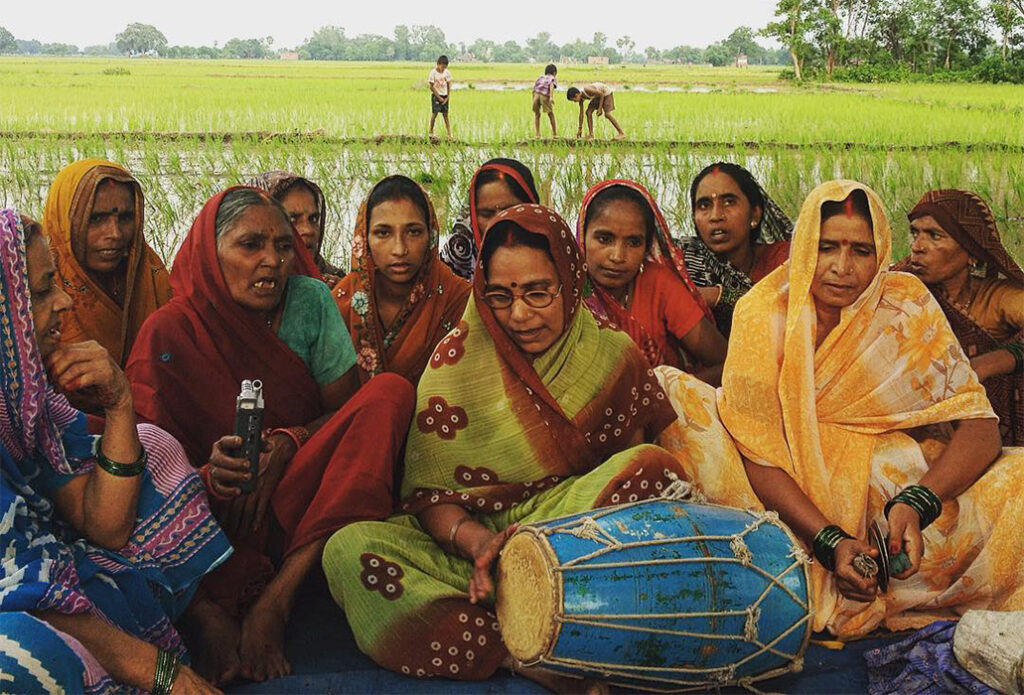
Rajat Nayyar, a filmmaker, anthropologist and 2020 Vanier Scholar in the Department of Theatre, demonstrates how power hierarchies are subverted through song in his upcoming film and recent article in Visual Anthropology Review (VAR).
Beginning in the state of Bihar in 2015, Nayyar’s project was originally a response to a call for the documentation of cultural heritage issued by the state government. His team became fixtures at a Hindu temple in Badhuli – a pseudonym they used for the village to protect local collaborators – where upper-caste women sought to demonstrate their singing for the documentation drive. However, it was Aaji, a lower-caste woman, who captured Nayyar’s attention when she ventured in to perform Ropani songs that are sung by lower-caste women while working in the rice fields.
It was clear to Nayyar that Aaji’s Ropani songs initially made upper-caste visitors to Badhuli’s temple uncomfortable. Her songs were long and unfamiliar to upper-caste women. It was Aaji’s distinctive voice that drew Nayyar to her as the central figure in his ethnography.
Over a month, Nayyar archived a range of musical styles from various singers, but remained transfixed on the task of documenting Aaji’s daily life and studying the unique power dynamics she cultivated. Nayyar returned to Badhuli frequently between 2015 and 2018 to produce his own ethnographic film with Aaji and share their work with the village. In November, Nayyar published Granular Activisms: Women’s Vocality and Multimodality in Rural North India in VAR, showcasing the breadth of his work across successive visits to Badhuli.
“Our collaborative film project was initially directed toward studying Aaji’s relationship with singing,” Nayyar states in his article. “However, it later transformed into an interventionist project that [constituted] a performance space in the village [that highlighted] the politics of women’s vocal traditions.”

Emphasizing her extensive musical training with her mother, Nayyar wrote that Aaji “recalls how the mother-daughter team would work tirelessly in the rice fields while singing Ropani songs; if Aaji would forget a line or two or use the wrong vocalizing technique, pitch, or range, her mother would make her repeat that song several times on their way back home.”
Aaji told Nayyar how over the years, despite her lower caste, villagers began to recognize her undeniable talent and extensive repertoire, requesting that she sing at their weddings and other rituals. Soon, she was a highly sought-after wedding performer within Badhuli and beyond.
“I used to be sleeping at home and suddenly somebody would come and wake me up to sing at their wedding,” Aaji said. “In my old age, I am too exhausted to go and sing… but then, refusing their invitation is not an option since people will take it personally.”
Radical performance
Throughout the project, Aaji began to lead singing gatherings in the village every evening. Dozens of community members – including upper-caste women and men – would jump at the chance to sing and play instruments with her. The power of Aaji’s singing brought together community members in unprecedented ways, temporarily shattering the divisions that usually exist in the highly gendered, casteist context of village weddings and other events. In fact, Aaji’s choice of songs would inspire other women within these gatherings to draw on their own vocal traditions, even including songs of the Gaari genre, in which women sing abuses at their husbands and other men in their family.
“This radical politics of women’s vocal traditions came as a revelation,” Nayyar wrote.
Nayyar reflected on the Barthesian concept of “grain,” which is like the personality of an author engraved in their work. Separate from lyrical meaning, vocal grain is like the unique wobbles in a person’s penmanship that can make the author identifiable without considering the narrative meaning.
In describing how these vocal traditions carry meaning for, and inspire action in, Aaji and other community members – even when identity or social status are not shared – Nayyar has coined the term “granular activism.”
Nayyar hopes to inspire audiences outside of Canada and India to consider divisions in gender, race, caste and class, and how these are challenged through the singing voice. Ultimately, his “goal is to extend the scholarship on women’s vocal traditions and resistance studies beyond the confines of folk songs’ literal meaning.”
